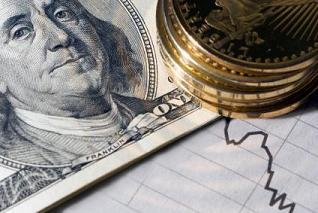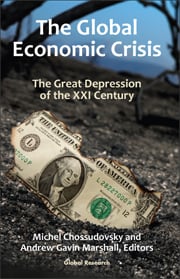Stock Market Collapse: More Goldman Market Rigging

Last week, Goldman Sachs was on the congressional hot seat, grilled for fraud in its sale of complicated financial products called “synthetic CDOs.” This week the heat was off, as all eyes turned to the attack of the shorts on Greek sovereign debt and the dire threat of a sovereign Greek default. By Thursday, Goldman’s fraud had slipped from the headlines and Congress had been cowed into throwing in the towel on its campaign to break up the too-big-to-fail banks. On Friday, Goldman was in settlement talks with the SEC.
Goldman and Wall Street reign. Congress appears helpless to discipline the big banks, just as the European Central Bank appears helpless to prevent the collapse of the European Union. . . . Or are they?
Suspicious Market Maneuverings
The shorts circled like sharks in the Greek bond market, following a highly suspicious downgrade of Greek debt by Moody’s on Monday. Ratings by private ratings agencies, long suspected of being in the pocket of Wall Street, often seem to be timed to cause stocks or bonds to jump or tumble, causing extreme reactions in the market. The Greek downgrade was suspicious and unexpected because the European Central Bank and International Monetary Fund had just pledged 120 billion Euros to avoid a debt default in Greece.
Markets were roiled further on Thursday, when the U.S. stock market suddenly lost 999 points, and just as suddenly recovered two-thirds of that loss. It appeared to be such a clear case of tampering that Maria Bartiromo blurted out on CNBC, “That is ridiculous. This really sounds like market manipulation to me.”
Manipulation by whom? Markets can be rigged with computers using high-frequency trading programs (HFT), which now compose 70% of market trading; and Goldman Sachs is the undisputed leader in this new gaming technique. Matt Taibbi maintains that Goldman Sachs has been “engineering every market manipulation since the Great Depression.” When Goldman does not get its way, it is in a position to throw a tantrum and crash the market. It can do this with automated market making technologies like the one invented by Max Keiser, which he claims is now being used to turbocharge market manipulation.
Goldman was an investment firm until September 2008, when it became a “bank holding company” overnight in order to capitalize on the bank bailout, including borrowing virtually interest-free from the Federal Reserve and other banks. In January, when President Obama backed Paul Volcker in his plan to reinstate a form of the Glass-Steagall Act that would separate investment banking from commercial banking, the market collapsed on cue, and the Volcker Rule faded from the headlines.
When Goldman got dragged before Congress and the SEC in April, the Greek crisis arose as a “counterpoint,” diverting attention to that growing conflagration. Greece appears to be the sacrificial play in the EU just as Lehman Brothers was in the U.S., “the hostage the kidnappers shoot to prove they mean business.”
The Nuclear Option
It is still possible, however, for the European Central Bank to snatch Greece from the fire and rout the shorts. It can do this with what has been called the nuclear option — “monetizing” the debt of Greece and other debt-laden EU countries by effectively “printing money” (quantitative easing) and buying the debt itself at very low interest rates. This is called the “nuclear option” because it would blow up the hedge funds and electronic sharks operated by Goldman and other Wall Street heavies, which specialize in bringing down corporations and whole countries for strategic and exploitative ends.
Will the ECB proceed with this plan? Perhaps, say some experts. It could just be waiting for the German election on Sunday, which the ECB does not want to appear to be influencing.
Ellen Brown developed her research skills as an attorney practicing civil litigation in Los Angeles. In Web of Debt, her latest of eleven books, she turns those skills to an analysis of the Federal Reserve and “the money trust.” She shows how this private cartel has usurped the power to create money from the people themselves, and how we the people can get it back. Her websites are www.webofdebt.com, www.ellenbrown.com, and www.public-banking.com. \
Read Ellen Brown’s chapters in this Global Research Book on the Global Economic Crisis:
Chapter 16. The Towers of Basel: Secretive Plan to Create a Global Central Bank Ellen Brown
Chapter 19. Wall Street’s Ponzi Scheme Ellen Brown

The Global Economic Crisis. The Great Depression of the XXI Century, Michel Chossudovsky and Andrew Gavin Marshall (Editors), Montreal, Global Research, 2010, which is to be launched in late May.
Each of the authors in this timely collection digs beneath the gilded surface to reveal a complex web of deceit and media distortion which serves to conceal the workings of the global economic system and its devastating impacts on people’s lives.
The complex causes as well as the devastating consequences of the economic crisis are carefully scrutinized with contributions from Ellen Brown, Tom Burghardt, Michel Chossudovsky, Richard C. Cook, Shamus Cooke, John Bellamy Foster, Michael Hudson, Tanya Cariina Hsu, Fred Magdoff, Andrew Gavin Marshall, James Petras, Peter Phillips, Peter Dale Scott, Bill Van Auken, Claudia von Werlhof and Mike Whitney.
Despite the diversity of viewpoints and perspectives presented within this volume, all of the contributors ultimately come to the same conclusion: humanity is at the crossroads of the most serious economic and social crisis in modern history.
For details on the book click here. The book can be ordered directly from Global Research

